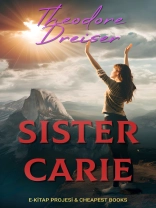In Sister Carrie, Dreiser portrayed a changing society, writing about a young woman who flees rural life for the city (Chicago) and struggles with poverty, complex relationships with men, and prostitution. It sold poorly and was considered controversial because of moral objections to his featuring a country girl who pursues her dreams of fame and fortune through relationships with men.
The book has since acquired a considerable reputation. It has been called the ‘greatest of all American urban novels.’ It was adapted as a 1952 film by the same name, directed by William Wyler and starring Laurence Olivier and Jennifer Jones.
‘..When Caroline Meeber boarded the afternoon train for Chicago, her total outfit consisted of a small trunk, a cheap imita-tion alligator-skin satchel, a small lunch in a paper box, and a yellow leather snap purse, containing her ticket, a scrap of paper with her sister’s address in Van Buren Street, and four dollars in money. It was in August, 1889.
She was eighteen years of age, bright, timid, and full of the illusions of ignorance and youth. Whatever touch of regret at parting characterised her thoughts, it was certainly not for advantages now being given up. A gush of tears at her mother’s farewell kiss, a touch in her throat when the cars clacked by the flour mill where her father worked by the day, a pathetic sigh as the familiar green environs of the village passed in review, and the threads which bound her so lightly to girlhood and home were irretrievably broken..’












